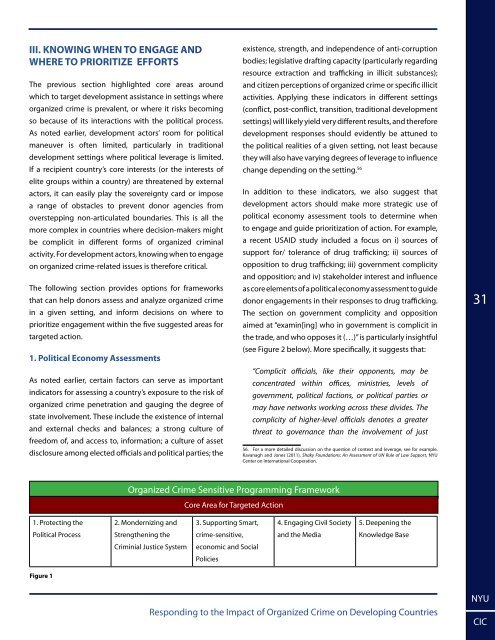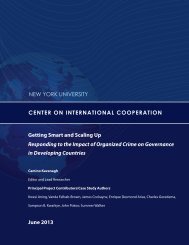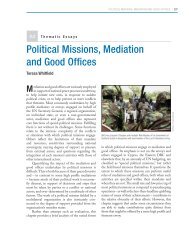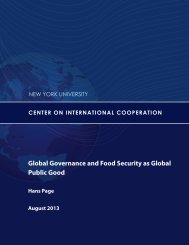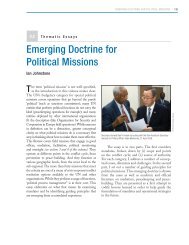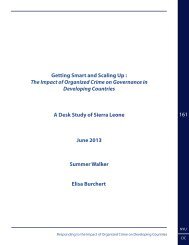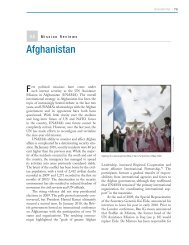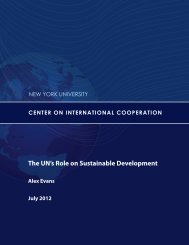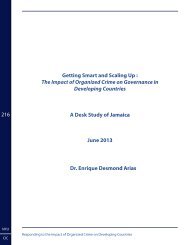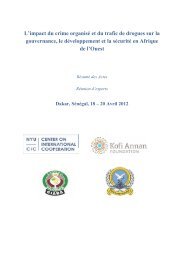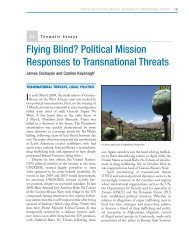here - Center on International Cooperation - New York University
here - Center on International Cooperation - New York University
here - Center on International Cooperation - New York University
Create successful ePaper yourself
Turn your PDF publications into a flip-book with our unique Google optimized e-Paper software.
III. KNOWING WHEN TO ENGAGE AND<br />
WHERE TO PRIORITIZE EFFORTS<br />
The previous secti<strong>on</strong> highlighted core areas around<br />
which to target development assistance in settings w<str<strong>on</strong>g>here</str<strong>on</strong>g><br />
organized crime is prevalent, or w<str<strong>on</strong>g>here</str<strong>on</strong>g> it risks becoming<br />
so because of its interacti<strong>on</strong>s with the political process.<br />
As noted earlier, development actors’ room for political<br />
maneuver is often limited, particularly in traditi<strong>on</strong>al<br />
development settings w<str<strong>on</strong>g>here</str<strong>on</strong>g> political leverage is limited.<br />
If a recipient country’s core interests (or the interests of<br />
elite groups within a country) are threatened by external<br />
actors, it can easily play the sovereignty card or impose<br />
a range of obstacles to prevent d<strong>on</strong>or agencies from<br />
overstepping n<strong>on</strong>-articulated boundaries. This is all the<br />
more complex in countries w<str<strong>on</strong>g>here</str<strong>on</strong>g> decisi<strong>on</strong>-makers might<br />
be complicit in different forms of organized criminal<br />
activity. For development actors, knowing when to engage<br />
<strong>on</strong> organized crime-related issues is t<str<strong>on</strong>g>here</str<strong>on</strong>g>fore critical.<br />
The following secti<strong>on</strong> provides opti<strong>on</strong>s for frameworks<br />
that can help d<strong>on</strong>ors assess and analyze organized crime<br />
in a given setting, and inform decisi<strong>on</strong>s <strong>on</strong> w<str<strong>on</strong>g>here</str<strong>on</strong>g> to<br />
prioritize engagement within the five suggested areas for<br />
targeted acti<strong>on</strong>.<br />
1. Political Ec<strong>on</strong>omy Assessments<br />
As noted earlier, certain factors can serve as important<br />
indicators for assessing a country’s exposure to the risk of<br />
organized crime penetrati<strong>on</strong> and gauging the degree of<br />
state involvement. These include the existence of internal<br />
and external checks and balances; a str<strong>on</strong>g culture of<br />
freedom of, and access to, informati<strong>on</strong>; a culture of asset<br />
disclosure am<strong>on</strong>g elected officials and political parties; the<br />
existence, strength, and independence of anti-corrupti<strong>on</strong><br />
bodies; legislative drafting capacity (particularly regarding<br />
resource extracti<strong>on</strong> and trafficking in illicit substances);<br />
and citizen percepti<strong>on</strong>s of organized crime or specific illicit<br />
activities. Applying these indicators in different settings<br />
(c<strong>on</strong>flict, post-c<strong>on</strong>flict, transiti<strong>on</strong>, traditi<strong>on</strong>al development<br />
settings) will likely yield very different results, and t<str<strong>on</strong>g>here</str<strong>on</strong>g>fore<br />
development resp<strong>on</strong>ses should evidently be attuned to<br />
the political realities of a given setting, not least because<br />
they will also have varying degrees of leverage to influence<br />
change depending <strong>on</strong> the setting. 56<br />
In additi<strong>on</strong> to these indicators, we also suggest that<br />
development actors should make more strategic use of<br />
political ec<strong>on</strong>omy assessment tools to determine when<br />
to engage and guide prioritizati<strong>on</strong> of acti<strong>on</strong>. For example,<br />
a recent USAID study included a focus <strong>on</strong> i) sources of<br />
support for/ tolerance of drug trafficking; ii) sources of<br />
oppositi<strong>on</strong> to drug trafficking; iii) government complicity<br />
and oppositi<strong>on</strong>; and iv) stakeholder interest and influence<br />
as core elements of a political ec<strong>on</strong>omy assessment to guide<br />
d<strong>on</strong>or engagements in their resp<strong>on</strong>ses to drug trafficking.<br />
The secti<strong>on</strong> <strong>on</strong> government complicity and oppositi<strong>on</strong><br />
aimed at “examin[ing] who in government is complicit in<br />
the trade, and who opposes it (…)” is particularly insightful<br />
(see Figure 2 below). More specifically, it suggests that:<br />
“Complicit officials, like their opp<strong>on</strong>ents, may be<br />
c<strong>on</strong>centrated within offices, ministries, levels of<br />
government, political facti<strong>on</strong>s, or political parties or<br />
may have networks working across these divides. The<br />
complicity of higher-level officials denotes a greater<br />
threat to governance than the involvement of just<br />
56. For a more detailed discussi<strong>on</strong> <strong>on</strong> the questi<strong>on</strong> of c<strong>on</strong>text and leverage, see for example,<br />
Kavanagh and J<strong>on</strong>es (2011), Shaky Foundati<strong>on</strong>s: An Assessment of UN Rule of Law Support, NYU<br />
<str<strong>on</strong>g>Center</str<strong>on</strong>g> <strong>on</strong> Internati<strong>on</strong>al Cooperati<strong>on</strong>.<br />
31<br />
Organized Crime Sensitive Programming Framework<br />
Core Area for Targeted Acti<strong>on</strong><br />
1. Protecting the<br />
2. M<strong>on</strong>dernizing and<br />
3. Supporting Smart,<br />
4. Engaging Civil Society<br />
5. Deepening the<br />
Political Process<br />
Strengthening the<br />
crime-sensitive,<br />
and the Media<br />
Knowledge Base<br />
Criminial Justice System<br />
ec<strong>on</strong>omic and Social<br />
Policies<br />
Figure 1<br />
Resp<strong>on</strong>ding to the Impact of Organized Crime <strong>on</strong> Developing Countries<br />
NYU<br />
CIC


